Bomengids.nl: Winter key for Dutch and European hardwoods.
Recognizing trees in the winter is more difficult: there are no leafs to guide you. You can try to determine what genus or even species a tree belongs to however by mainly making use of buds and bark.
But it also helps to use elimination: just as is done in the main-key we can eliminate many species without looking at difficult details. What is left is a smaller group of possibilities. Therefore the winter-elimination key on this page has many similarities to the general main-key.
When this first part of the winter-section does not help you find out what species a tree belongs to, you can use the bud-key and the bark key.
Winter elimination key for Dutch hardwoods.
1. White bark | 2. Light-greyish-to white bark | 3. Camouflage bark | 4. Alder-cones | 5. Winged-fruits / bunches of small stalks | 6. Balls | 7. Green/grey long round peas | 8. Brown flat peas | 9. Hanging long twigs/ branches | 10. Strings hanging down | 11. Column shaped tree 12. Bark with shining horizontal bands 13. Very rough brown/greyish bark 14. Trunk is twisted. 15. Bark has pieces missing. 16. Bark/bud key.As in the summer some trees are easily recognized in the winter as well. We will start to name these. Only when a tree is not in this group we will have to revert to a bark-and-bud key.
0. This is a key for Dutch (West-European) hardwoods.
Trees with leafs, thus no conifers. I define a tree as an individual belonging to a species that can grow upto 10 metres.
1. Smooth and white often shiny bark.
Often with strips that hang loose. Birch. 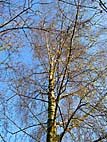 Birchfamily . Birches are easily recognizable. Determining what species you have exactly can be hard in winter and summer.
Birchfamily . Birches are easily recognizable. Determining what species you have exactly can be hard in winter and summer.
2. Bark is light-greyish-to-white. Often with small diamonds-shaped structures in rows.
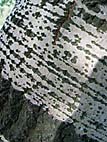 but it is no Birch: white/grey Poplar or Aspen. Poplarfamily. Easily recognizable in the winter. Only determining what species you have can be tough. The bark of Aspen is more finely-structured as the poplars and has no rough brown bark usually. But the difference between the white and grey poplar is impossible.
but it is no Birch: white/grey Poplar or Aspen. Poplarfamily. Easily recognizable in the winter. Only determining what species you have can be tough. The bark of Aspen is more finely-structured as the poplars and has no rough brown bark usually. But the difference between the white and grey poplar is impossible.
3. Bark looks like camouflage-fabric:
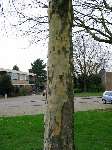 pale green/yellowish patches where bark has loosened. Planetree.
pale green/yellowish patches where bark has loosened. Planetree.
Easily recognized in the winter as in the summer. Also often still fruit on the twigs: small balls. In the Netherlands the London planetree is common in parks. Knowing if you happen to meet another species is almost impossible to see in the winter: the buds can help however.
4. Alder bullets/mini-cones
The tree has black round dried-out catkins (catkins from last year). These look like small cones like those from pines. 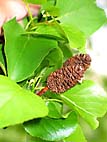 -> Probably an Alder. Alderfamily . In the winter the Alder also has long catkins and the twigs are rather stuffed with all kinds of things. This makes it well recognizable. Knowing which species you have can be difficult without leaves.
-> Probably an Alder. Alderfamily . In the winter the Alder also has long catkins and the twigs are rather stuffed with all kinds of things. This makes it well recognizable. Knowing which species you have can be difficult without leaves.
Some Ashes sometimes have bunches of old dried-out flowers that have turned black and look a bit like the alder-bullets. The black former-flowers of the Ash however come in bunches and the alder-cones sit alone. Ashes also do not have hanging catkins.
Furthermore you can recognize an Ash easily by its characteristic three large buds on the end of twigs that look a bit like the hoofs of a roe-deer.
5. Wings
A tree has fruit in the form of wings. Hanging alone or in bunches. Also bunches of stalks without the wings are a good sign by which you can recognize these species.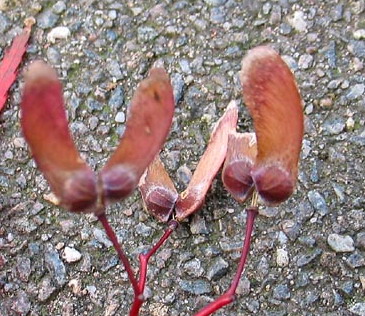 :
:
Either a species of Ash or Maple (two different families). Ashes can be easily recognized by their buds that look like the hooves of a roe-deer. The dominant Maple-species in the Netherlands have very distinct buds also: usually bright red or green. Maples often have lost the winged-fruits but do still have the bunches of stalks the fruits were attached to.
When the buds are red you might also have a Linden on your hands. These have no winged-fruits but their fruit also has bunches of stalks with one special leaf above it. This leaf can remain on the twigs long in the winter.
The Black locust has small brown flat peas that might look like wings also. This tree however has very characteristic rough bark. Also has long thorns on the twigs.
6. Balls
Tree has fruit with a ball-form often with thorns on it:
- Under a Sweet chestnut and Horse chestnut
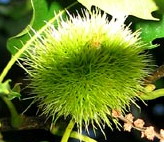
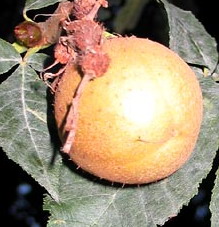 one often finds remains of the fruits on the ground next to the trees. Very few trees have some of this still on the tree itself.
one often finds remains of the fruits on the ground next to the trees. Very few trees have some of this still on the tree itself. - Some Ashes
 have bunches of old dried-out flowers that have turned black that look like bunches of balls. you can recognize an Ash easily by their characteristic big buds that look a bit like the foot of a roe-deer.
have bunches of old dried-out flowers that have turned black that look like bunches of balls. you can recognize an Ash easily by their characteristic big buds that look a bit like the foot of a roe-deer. - Planetree .
Often has its fruit in the form of balls on the branches in the winter. Easily recognized also by its "camouflage" bark.

- Sweetgum .
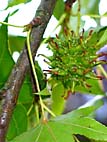 An American species used in parks and lanes. Has fruit in the form of balls also. Often has cork-edges on branches, but not always.
An American species used in parks and lanes. Has fruit in the form of balls also. Often has cork-edges on branches, but not always.
- The European beech or Fagus sylvatica
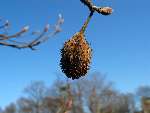 sometimes has some brown thorny fruit-wrapping left on its trees. More often on the ground though and not always. Well identifiable by its smooth bark and its long slender light-brown buds.
sometimes has some brown thorny fruit-wrapping left on its trees. More often on the ground though and not always. Well identifiable by its smooth bark and its long slender light-brown buds.
7. A tree has long round greyish/green peas
for fruit. Up to 50 cm long. Catalpa . In winter often many peas are left on the tree. Once green, the peas have turned greyish and are dried-out. This species is not easy to recognize without its peas. Not always do the peas stay on the tree in winter.
8. Tree has flattened brown peas on its branches.
:
- Black locust (with long paired thorns on the braches) or
- other leguminosa like Honey locust (with or without groups of thorns) and Kentucky coffeetree.
Of these species the Black locust is imported in the 19th century, but is common now in the Netherlands. You can find them even in forests. The honeylocust is planted in parks mainly. Honeylocust can be difficult to recognize if it has no thorns or fruit. When it does the very long curled brown peas are easy to spot. Its thorns are one of the kind: in bunches and coming out of the trunk you will find nothing else like it. Black locust is easily recognized by its characteristic rough bark. It almost always has some small flat bursted-open peas left hanging on the tree.
9. Tree has branches/twigs that hang down like strings.
- European white birch of the Birchfamily , recognized by its white bark.
- Weeping willow , with its small buds in winter.
- Other cultivar species that "weep". There are species of Birch that do and even Beeches.
10. Tree has string-like stalks hanging down.
:
Caucasian wingnut. 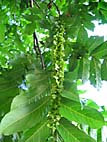 This tree often has stalks hanging down like strings that used to bear the fruits. Looks like a children's party where all balloons have bursted and only the strings remain on the ceiling. A broad tree that branches out low usually. Looks a bit like horse-chestnut in its form but has extremely rough grey bark.
This tree often has stalks hanging down like strings that used to bear the fruits. Looks like a children's party where all balloons have bursted and only the strings remain on the ceiling. A broad tree that branches out low usually. Looks a bit like horse-chestnut in its form but has extremely rough grey bark.
11. Tree is column-shaped.
- If it is really high often a Lombardy poplar . Also easily recognized. A very rough bark, with twigs that are not smooth at all. Often many small twigs growing straight up from the trunk.
- There are also cultivar oaks that are column-shaped. Can be often recognized by brown leafs still in the tree or by the brown buds that appear in bunches at the end of twigs.
- It can also be another cultivar tree. Musclewood (hornbeam) also has forms that are column-shaped. But there are more possibilities.
12. Trunk with shiny horizontal strips of bark. Sometimes between patches of rough bark, sometimes all the trunk is shiny.

Almost always a Prunus or Cherry species. You can find these in the forest but also often in parks and streets: because of their beautiful flowers in early spring.
The buds are brown and in bunches.
13. Very coarse brown/greyish bark.
The Black locust  has a very characteristic bark. If you suspect a Black locust looking for thorns and peas in the tree will almost always help you out. There are no visible buds until April. This locust looks a bit like an English oak shape-wise: very twisted branches.
has a very characteristic bark. If you suspect a Black locust looking for thorns and peas in the tree will almost always help you out. There are no visible buds until April. This locust looks a bit like an English oak shape-wise: very twisted branches.
Another species with  coarse greyish bark is Caucasian wingnut. This tree is more broad in shape, where the locust is more a tall tree. Recognizable in winter by strings hanging down from the twigs.
coarse greyish bark is Caucasian wingnut. This tree is more broad in shape, where the locust is more a tall tree. Recognizable in winter by strings hanging down from the twigs.
14. Trunk is twisted
Sometimes trees have a twist in the trunk. Some species sometimes have this and other species very often. Species that sometimes are twisted by trunk are :
Species in the Lindengenus or Tilia (Tilaceae )
Red oak or Quercus rubra
European Beech or Fagus sylvatica
European hornbeam; Musclewood; or Carpinus betulus
A species that is almost always twisted by trunk is the
Horse chestnut or Aesculus hippocastanum. Not 100% always, but more often than not. Trunk is often gray with square-patches that often loosen here and there. Often has a candlestick shape: very thick branches that branch low on the trunk.
15. Bark has loosened patches.
Planetrees (Platanus hybrida London planetree) have this. Also Sycamore maple Acer pseudoplatanus sometimes has this. Recognizable by bunches of stalks where the winged-fruits used to be attached and by its beautiful green buds. The Horsechestnut or Aesculus hippocastanum has the same thing when it gets older.
16. Bark/bud key.
When you are here you have a tree without leafs and other distinguishable characteristics and you want to know what species it is. No remains of fruits in the tree and a common bark. Your rescue may lay in the bark/bud key on the following pages.Before we begin the bark/bud key some general remarks.
Buds of trees are good characteristics to use for determination. There seems to be little variation between individuals in a species. At the end of the winter however buds do change form and size as they are almost becoming leafs.
Bark is another story completely. There is an enormous variation between individuals within a species. Firstly in species with a coarse bark, young trees often begin with a smooth bark, which changes through its lifetime into coarse. The size of the tree at which this happens differs greatly. Therefore recognizing a young tree is more difficult than a large tree: all young trees have smooth bark. Moreover, small trees look a lot like shrubs and there are many species of shrubs. When trees have leaves this is less of a problem, but in winter it is.
Secondly bark is different even on a single tree: one side of a tree can have more corky bark than the other side, and also algae can color bark green in different ways around the tree. Also bark on the branches is different than on the trunk, and so on.
Most species that get a coarse bark begin to show this when the trunk is thicker than three to five wine-bottles, that is when the outline is more than 40 Cm's. When I say in this guide that a tree has a coarse bark it has to do with trees that are bigger than this.
Recognizing Dutch hardwoods by bark and buds starts over here.
